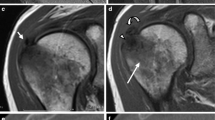Abstract
Intratendinous deposits of hydroxyapatite crystals are very common, particularly in the rotator cuff. In rare cases, the calcium located in the thickness of the supraspinatus tendon can suffer intraosseous migration into the greater tuberosity. We present a case of this rare entity: a 28-year-old patient who attended with pain and functional weakness in the left shoulder. The plain radiograph showed a sclerotic lesion in the greater tuberosity of the humeral head with a radiolucent halo. The MRI showed a lytic lesion containing the calcium inside and associated with an extensive pattern of oedema of the accompanying bone marrow. A plain radiograph taken 6 months before showed a calcifying tendinitis in the thickness of the supraspinatus tendon. A large number of entities can present as single sclerotic lesions of the humeral head. The diagnostic key lies in the existence of the calcifying tendinitis in the earlier study. The treatment of this disease consists of surgical removal of the calcium. The recognition of this entity is important to avoid unnecessary complementary tests and aggressive surgery, given that the surgical treatment is curative and leads to disappearance of the symptoms.




Similar content being viewed by others
References
Moseley HF (1963) The natural history and clinical syndromes produced by calcified deposits in the rotator cuff. Surg Clin North Am 43:1489–1493
Resnick (2002) Calcium hydroxyapatite crystal deposition disease In: Diagnosis of bone and joint disorders, 4th edn. Saunders, Philadelphia, pp 1620–1631
Chagnaud C, Gaubert JY, Champsaur P, Marciano S, Petit P, Moulin G (1998) Vanishing osteosclerotic lesion of the humeral head. Skeletal Radiol 27(1):50–52
Adler CP, Wenz W (1981) Intraosseous osteolytic lesions. Diagnostic, differential diagnosis and therapy. Radiologe 21(10):470–479
Greenspan A (1995) Bone island (enostosis): current concept. A review. Skeletal Radiol 24(2):111–115
Greenspan A (1993) Bening bone-forming lesions: osteoma, osteoid osteoma, and osteoblastoma. Clinical, imaging, pathologic, and differential considerations. Skeletal Radiol 22(7):485–500
Author information
Authors and Affiliations
Corresponding author
Additional information
Precisely correct answer was received by closing date from:
Christoph Hefel, Feldkirch, Austria
Elena Drakonaki, Heraklion, Greece
David Nucci, Grosseto, Italy
Siegfried Schwab, Erlangen, Germany
Meric Tuzun, Ankara, Turkey
Matthias Eiber, Munich, Germany
Manabu Minami, Ibaraki, Japan
Muneesh Sharma, Nassau, The Bahamas
Umapathi Mahesh, Chennai, India
Annemie Snoeckx, Antwerp, Belgium
Naganathan B.S. Mani, Chesterfield, MO, USA
Benoit Barbier-Brion, Besançon, France
Vincenzo Genchi, Bari, Italy
Je Hoon Yang, São Paulo, Brasil
Rights and permissions
About this article
Cite this article
Martin, S., Rapariz, J.M. Intraosseous calcium migration in calcifying tendinitis: a rare cause of single sclerotic injury in the humeral head (2010: 2b). Eur Radiol 20, 1284–1286 (2010). https://doi.org/10.1007/s00330-009-1500-9
Received:
Revised:
Accepted:
Published:
Issue Date:
DOI: https://doi.org/10.1007/s00330-009-1500-9




